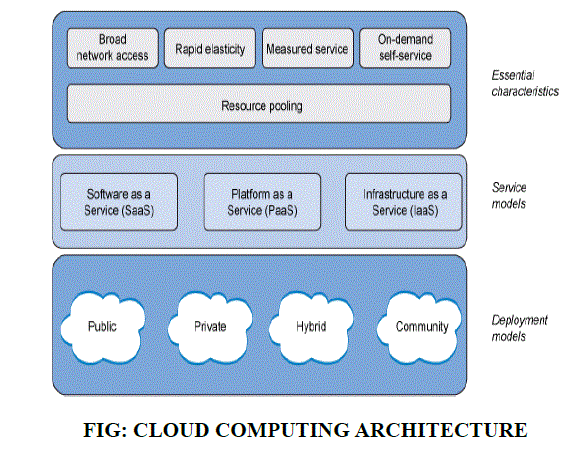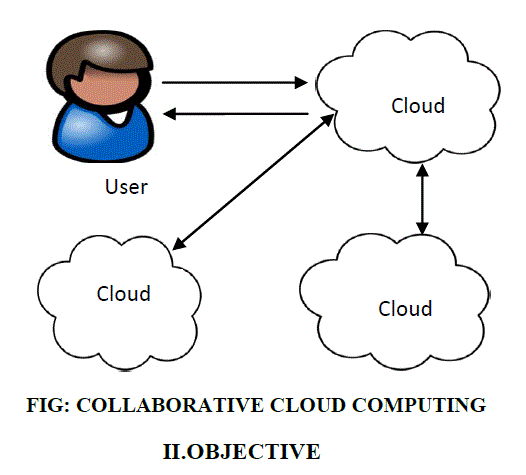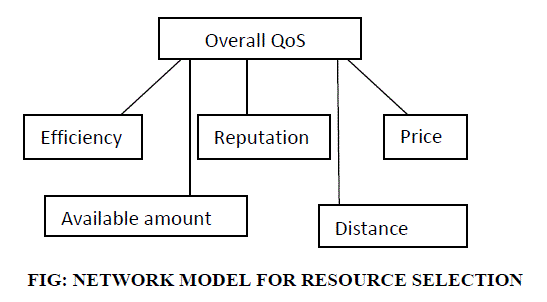ISSN ONLINE(2319-8753)PRINT(2347-6710)
ISSN ONLINE(2319-8753)PRINT(2347-6710)
W.Renuka Devi 1, K.Sudhakar2
|
| Related article at Pubmed, Scholar Google |
Visit for more related articles at International Journal of Innovative Research in Science, Engineering and Technology
In many researches they have created one environment with multiple clouds for scalable capabilities. The demand for scalable resources in some applications has been rapidly increased. By understanding the mutual dependencies between resources, utilization of users, user preferences a collaborative cloud computing has been introduced, It can be achieve emphasized efficient management of resources and user satisfaction between distributed resources in Collaborative cloud computing. These which do collaboratively supported by many organizations (Google, Microsoft, Amazon). Collaborative cloud computing (CCC) is next logical step in evolution of cloud and service grid technologies. Here mainly discussing about how resource selection done in collaborative cloud, resource selection based on user preferences, which mostly user preferred resources. This environment is to point out the suitable resources, ability and capability of resources, user requirements, and availability of resources. So that users can choose credible cloud platform.
Keywords |
| cloud computing, resource selection, resource sharing, collaborative Cloud computing (CCC), reputation management, and resource management |
INTRODUCTION |
| Cloud computing emerging technology, it is development of the parallel computing, distributed computing, and grid computing, utility computing. Cloud computing is considered as the future model for the computing. It gives the user ability to store data and access data using internet. It included services like Software-as-a-service(SaaS),Infrasturcture-as-service(IaaS),Platform-as-aservice( PaaS)[1].To users, cloud computing is a Pay-Per-Use-On-Demand that a conveniently access and shared resources through internet. In these cloud computing there are different cloud like public cloud, private cloud, hybrid cloud, community cloud. We know about the cloud computing is a security on technical level,here mainly focus on the attacks and hacking attempts. Many Business and industry owners are attracted to cloud computing concept due to many features due to many features. The features are as follows: |
| 1. Lower investment. |
| 2. Scalability |
| 3. Reliability and Security. |
| 4. Faster Deploy. |
 |
| In SaaS, a premade application, along with any required software, operating system, hardware, and network are provided. In PaaS, an operating system, hardwareand network are provided, and the customer installs or develop its own software and applications. In IaaS model provides just the hardware and network, the customer installs or develops its own operating systems, software and applications. Where in the collaborative cloud customers can choose a private, public, hybrid, community to support discrete services, here customers can achieve more value by integrating third party applications. Private clouds are owned and operated by third-party services provider, Public cloud is an open wide to public, Hybrid cloud is an composition of two or more distinct cloud infrastructure, community cloud is an provisioned for exclusive use by a specific community of consumers from organizations that have shared concerns. Where collaborative cloud is strategic framework for delivering communication services and applications to our customers and partners via cloud [2]. Customers can choose a private, public or hybrid to support discrete services, service provider partners all cloud solutions offer the same rich features are |
| Collaborative cloud frame work: |
| 1. Build with cloud-grade applications and infra structure. |
| 2. Manage part or all of your communications applications and infra structure. |
| 3. Deliver services through public and hybrid clouds. |
| 4. Enable service providers to deliver cloud services. |
Collaborative cloud computing |
| Collaborative cloud computing (CCC), where globally-scattered distributed cloud resources belong to different organizations or individuals are collectively used in cooperative manner to provide services to customers. |
| Collaborative cloud computing (CCC) platform is which interconnects the physical resources that allow sharing the resources between clouds and providers with huge amount of resources to customers, when a cloud doesn’t have sufficient resources then it will use resources form other clouds which they want. |
 |
| The objective of the paper is that to achieve enhanced efficient management of resources and user satisfaction between distributed resources in collaborative cloud using Multi-QoS oriented resource selection |
III.EXISTING SYSTEM |
| Collaborative cloud computing (CCC) operates in a large-scale environment involving thousands or millions of resources across disparate geographically distributed areas, and it is also inherently dynamic as entities may leave or enter the system and resource utilization and availability are continuously changing [3]. Due to autonomous and individual features of entities in CCC, different nodes provide different quality of service (QoS) in resource provision. A node may provide low QoS because of system problem or because it is not willing to provide high QoS in order to save costs.Also, nodes may be attacked by viruses and Trojan horse programs. |
| In previous resource management approach assume only a single QoS demand of users, such as either efficiency or security. Given a number of resource providers, the efficiency-oriented resource management policy would choose one with the highest available resource, while the security-oriented reputation management policy would choose one with highest reputation [3]. These may lead to a low service success rate, thus uncoordinated deployment of reputation management and resource management will exhibit different behaviors and significantly affect the effectiveness of both, finally overall performance will provide low quality. Reputation management systems neglect resource heterogeneity by assigning each node one reputation value for providing all of its resources. Systems are not effective enough to provide correct guidance for trustworthy individual resource selection..In existing system performs following steps: |
| 1. Integrated Multi-faceted resource and reputation management. 2. Multi-QoS oriented resource selection. 3. Price-assisted resource and reputation control. 4. Combination of three components. |
Integrated Multi-faceted resource and reputation Management |
| Integrated Resource Management (IRM) that involves four C’s they are compatibility, conflict, compromise, consultation [4].It provides a cooperative manner in resource sharing, which address multiple and diverse resources concerns. Integrated reputation is which managing or tracking the actions of an entity. A High reputed node based on its resource provision services for al types of high QoS for every type of resource. The resource information includes the resource provider IP address, resource type, available amount, resource location, price, etc. All these data is stored in a directory node, and forward the request to corresponding directory nodes. Similarly for reputation management [5] is done. |
Multi-QoSOriented Resource Selection |
| Multi-QoS oriented resource selection component helps to requesters to choose resource providers that offer the highest QoS attributes [3].Here resource selection based on the utility of resources [7]. |
 |
| After a directory node locates the resource providers that have the required reputation, available amount it helps to choose providers for the requesters.QoS is calculated based on distance efficiency, security, price, Trustworthiness [3]. A challenge here is how to consider individual or combined QoS attributes and a user’s desired priorities of the attributes in provider selection |
Price-assisted resource and reputation control |
| In this model, a node pays credits to a resource provider for offered resources, and a resource provider specifies the price of its resources [3][6].The credits could be either virtual money or real money. The price is the amount of credits to use one unit of resource for one time unit, in order to use other resource anode must provide its resource to others. Resources with higher reputations, lower loads, and higher demand should have high prices. Therefore, in order to earn more money, each node is motivated to provide high QoS to maintain high reputation, while avoiding being overloaded. It is which recognized as an effective way to provide high QoS. |
Combination of three components |
| In the integrated Multi-faceted resource and reputation management requester will send request to resource provider, after that request will store in directory node and finds all providers that satisfies the requester requirements [3]. A Multi QoS-Oriented Resource selection algorithm to identify the resource provider with highest overall QoS these will customer to choose right resource provider. A Price- Assisted Resource/Reputation control, the receiver pays a resource provider for provided resources with sufficient amount. |
| Contradictory behaviors pose two challenges. They are: |
| 1. How can jointly consider multiple QoS demands? |
| 2. How can we enable each node to actively control its reputation and resource supply? |
Drawbacks |
| 1. It is not efficient and trustworthy. |
| 2. Single-QoS assumption. |
IV.PROPOSED SYSTEM |
| To ensure the successful deployment of CCC, the issues of resource management and reputation management must jointly addressed for both efficient and resource sharing in three tasks such as efficiently locating required trustworthy resources, choosing resources from the available options and fully utilizing the resources in the system while avoiding overloading any node. It incorporates four innovations are: |
| 1. Integrated multi-faceted resource and reputation management. |
| 2. Multi-QoS-Oriented Resource Selection. |
| 3. Price-assisted resource and reputation control. |
| 4. User Preference identity. |
| By identifying and understanding mutual dependencies among resources, preferences of users and utilization of users, a collaborative cloud computing platform has introduced. |
User Preference Identity |
| A user preference identity is which preference id that was given by user with highest QoS with ratings to the resources. |
Multi-QoS Oriented Resource Selection |
| Multi QoS Oriented Resource Selection module helps users to choose resource providers that offer the highest QoS attributes. The resource overloaded control module gives preferences for low priced resources [6].Also; feedback system helps providers keep their reputations high by getting feedback from users to know its performance from time to time. Resource Providers that have required reputation, available amount, price, it needs requesters to choose provider. There are three types of nodes which are used for selection of a node they are: |
| 1. Altruistic-ranking of 1. |
| 2. Neural-ranking of 0.5. |
| 3. Egotistic –ranking of 0.1. |
| These nodes each of which will provides the service successfully with probabilities respectively. |
Overall QOS based resource selection |
| After a directory node discovers the resource provider that has obligatory reputation, available amount, price, it needs to choose provider for the requester. The final QoS obtained by a provider determined by a number of factors such as efficiency, trust, reliability, security which are the QoS demands. Inputs are the ratings of each QoS attribute, denoted by {A1, A2, A3…..An} and its output is the overall QoS value of the provider. The weight of influence of each attribute on the QoS denoted by (W1, W2, W3….Wn}.Thus, the function is Activation Function |
 |
Overall QoS based Resource Selection algorithm: |
 |
Advantages: |
| 1. Requesters can choose resource providers that offer high QoS. |
| 2. Avoids the overloaded income to users. |
V.CONCLUSION |
| In this paper, we propose a collaborative cloud computing platform for resource selection. The Multi-QoS Oriented Resource Selection module helps users to choose resource providers that offer the highest QoS attributes. This method provides an environment to point out its desired resources. Resource ability or capability, user’s requirements and also find the availability of resources which users need. It is efficient resource sharing and resource selection. |
References |
|